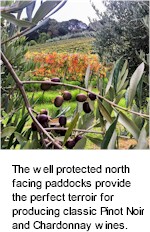


Founder Warwick Ross's family has had strong ties with the Portsea/Sorrento area since the late 1800s, when grandfather Dr. Frederick Kiel travelled regularly by paddle steamer as a young man from Melbourne to spend his summers at Sorrento. The Kiel family acquired Pembroke, an historic limestone cottage on Melbourne Road, as their summer residence, which remained in the family until the 1970s. The Kiels acquired the 40 acre Tintagel farm on Portsea Ocean Beach in 1956, a place of undulating paddocks and sweeping views of tempestuous Bass Strait. The subsequent acquisition of the adjoining 106 acres from the Baillieu family in the 1960s allowed the Ross family to expand their cattle grazing activities with the introduction of Angus and Hereford herds.

Portsea Estate's unique terroir derives from extensive limestone deposits and a top soil of calcareous sand and humus collected over thousands of years. The free draining, limestone rich soils provide ideal conditions for Pinot Noir and Chardonnay to thrive and have produced complex, layered wines of distinct character and minerality. Establishment of the Portsea Estate vineyard and label in 2000 was a natural progression, born out of a love for Burgundian wines, a connection with the beautiful Tintagel property and commitment to the Portsea/Sorrento area. The goal was to produce premium wines from grapes grown exclusively on the estate at Portsea.
Historically and geologically, the Portsea and Sorrento area represents one of the most significant and fascinating regions in Victoria. The first Victorian settlement in 1803 was at Sullivan Bay near Sorrento, where Captain David Collins and 300 convicts and settlers came ashore. Limeburners moved into the area to exploit the vast wealth of limestone deposits and limeburning established itself as the main industry from Point Nepean to Sorrento.
The well protected north facing paddocks on Portsea Estate vineyard were planted to Pinot Noir and Chardonnay, on unique free draining limestone and calcareous sands that lay beneath the paddocks, providing the perfect terroir for producing classic Pinot Noir and Chardonnay wines.

























